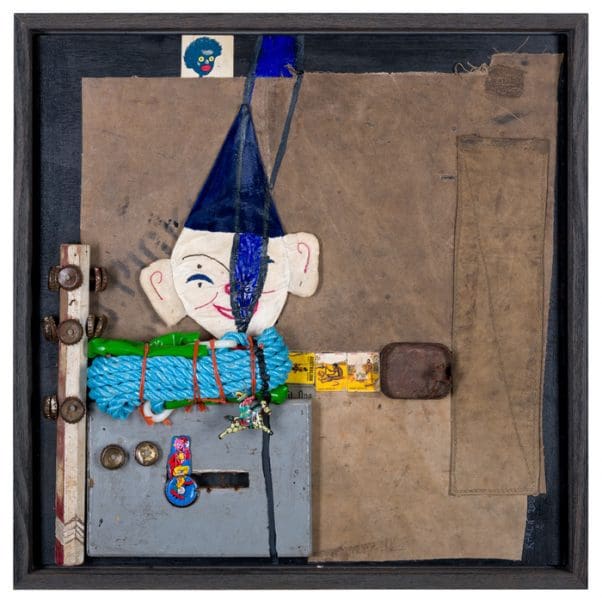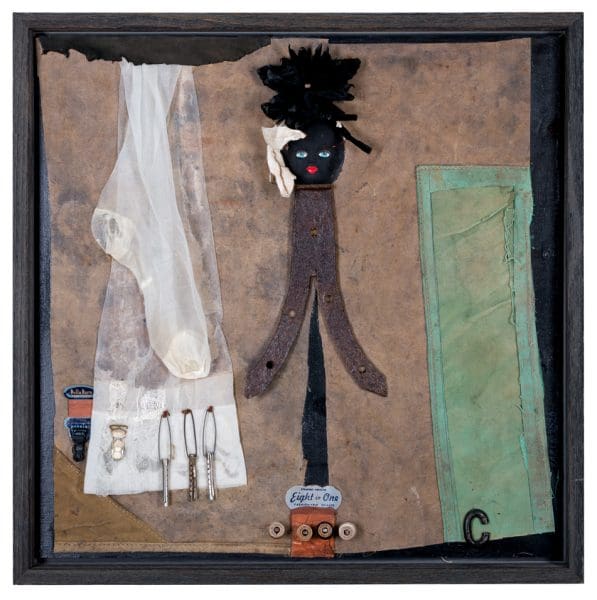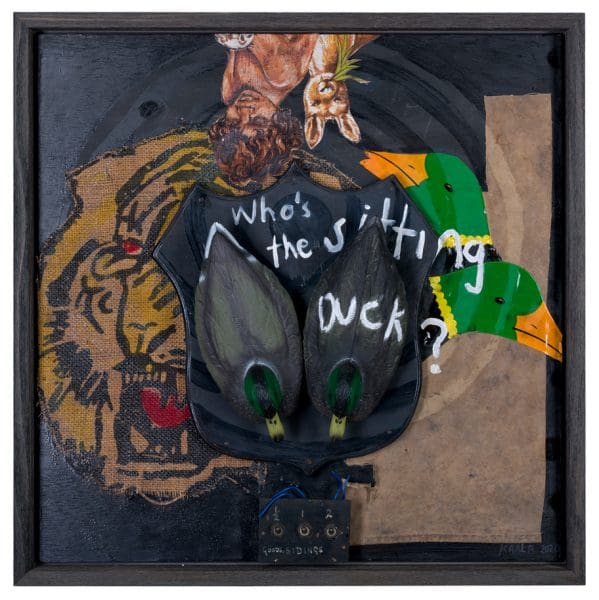
Finding New Spaces Together
‘Vádye Eshgh (The Valley of Love)’ is a collaboration between Second Generation Collective and Abdul-Rahman Abdullah weaving through themes of beauty, diversity and the rebuilding of identity.




Despite weathering months of lockdowns and social distancing, Lismore-based Wiradjuri artist Karla Dickens has been incredibly busy. Starting 2020 with significant bodies of work in the Adelaide Biennial of Australian Art and the 22nd Biennale of Sydney, Dickens now adds two new exhibitions to the mix: A Dickensian Sideshow at Lismore Regional Gallery and SOS at Andrew Baker Art Dealer in Brisbane.
Featuring her trademark multi-layered assemblages, Dickens augments her new work with viscerally charged poetry to construct a narrative that speaks to identity, discrimination and acts of violence against Aboriginal people. Tinged with sadness and a wicked sense of humour, the artist’s work also shines a light on resilience and strength through adversity. Briony Downes speaks to Dickens about her new work and why writing poetry has become an important part of her practice.

Briony Downes: A Dickensian Sideshow is currently showing in your hometown of Lismore. How did this exhibition come about?
Karla Dickens: A Dickensian Sideshow conjures up scenes from the dark side of the sideshow and is woven together from two previous bodies of work. A Dickensian Country Show, which was created for Monster Theatres, the 2020 Adelaide Biennial of Australian Art; and A Dickensian Circus, the work I installed in the vestibule of the AGNSW as part of NIRIN, the 22nd Biennale of Sydney. During the NSW Covid-19 lockdown, I created some new works for the show at Lismore Regional Gallery, and these will go on tour to Orange Regional Gallery in 2021.
The new series I made in lockdown is heavy collaged works, all grown on top of old worn tarps, with a serious theme of financial hardship – influenced by the focus on money through the 2020 lockdowns.
My work is always connected to the working class, yet A Dickensian Sideshow goes a step further, holding elements of the dirt poor (like references to the Great Depression and the dust of times of struggle) with a small amount of sparkle thrown in.
Some of the objects I’ve used are work gloves, old food cans, chicken feet and a mouse trap; 90% of the objects were sourced locally on Bundjalung country. And given the lockdown and closures of the tip shop, garage sales and op-shops, I focused on cleaning and organising my studio. This unearthed some real gems.
My new work contains more space than the collages created for Monster Theatres, mostly due to my unnecessary panic regarding my honey holes for sourcing odd bits and pieces not being open for a long period of time. That being said, I’m happy and grateful to live rurally where the lockdown came to an end sooner compared to other parts of the country and to also have a very healthy stock pile of mad collage materials in my studio.
BD: Poetry has played a big part in your practice as an additional form of expression. What compels you to write?
KD: The poetry came from a growing lack of interest in writing art statements about my work. I’m not an academic and the artist statements were feeling too tight to express the stories unfolding from the work I was creating.
I have been told my visual work is poetic so maybe it was a natural progression. With past hard-hitting works dealing with rape and the abuse of women, I found myself not wanting to speak to the work at openings, so the poetry proved helpful in directing people to my words and thoughts without having to run the risk of becoming overly emotional publicly, which can happen regardless.
Poetry helps me come to a better understanding of what I’m trying to say and hopefully that translates for others.

BD: Your exhibition SOS is showing at Andrew Baker Art Dealer. What kind of work does it contain?
KD: SOS is also built from a few different bodies of work. The photographs from the Ready, Willing and Able, 2019, series were originally printed on very large banners for the vestibule of AGNSW. Local models Jeff and Cindy stepped up to the roles as Boxer and Stripper and in these images, they both show an undeniable fighting spirit.
For SOS, the photographs have been printed and framed at a more manageable format. Also included are a few pieces I completed a number of years ago that have not – until now – seen the light of day outside of my studio. There are a number of new sculptural pieces constructed from vintage fire extinguishers laden with mining stickers and crosses. Game Over, 2020, and another larger extinguisher with a long hose, We are on fire (not in a sexy way), 2020, relate to my experience at the time.
Even though the news was Covid/money based, I was still reeling from the bushfires that had wiped out so much life and were now receiving the silent treatment from those in power.
BD: A large portion of the work in SOS is made using straightjackets. Why do you use the straightjacket as a recurring motif?
KD: I have used straightjackets in past works speaking to domestic violence, as they seem to be the perfect metaphor for looking at different social issues that keep us bound. SOS has a series of straightjackets covered in tea towels printed with Australian dollars. It’s titled Strapped by the love of money, 2020.
BD: What other found objects have you used in SOS?
KD: One of my favourite pieces in the show is No Sense, 2020, which is an old, yellow cash register that I have worked on, filling the cash drawers with nails, teeth, snake skin and a small Australian flag. Sitting alongside this work is a very beaten up STOP sign with the words ‘putting money first’ painted on it. I also have War and Order, 2020 – three vintage war helmets painted with dollar signs, crosses and some bling.
BD: SOS contains still photographs from Mother’s Little Helpers, a film you made in 2019 with Bunurong, Tasmanian and Yuin man Bruce Pascoe as the main protagonist. What is the background of this project?
KD: The film was commissioned by the Kandos School of Cultural Adaptation for an amazing project called An Artist, A Farmer and A Scientist walk into a bar. KSCA is a group of artists and writers who come together to explore the idea of adaptive cultural change. Over two days, I worked with Blacklock Media to make the film, which features Elder Bruce Pascoe walking through Gamilaraay Country near the town of Bingara in the north-east of NSW.
Walking alongside him are a group of Aboriginal primary school children from Bingara Central School. The children represent the next generation, who must be equipped with the right skills and knowledge to implement positive changes to continue to be successful custodians of the land. Along with the photographs, the handmade capes worn by the kids and Uncle Bruce are also part of SOS.
A Dickensian Sideshow
Karla Dickens
Lismore Regional Gallery
21 November 2020 – 21 February 2021
SOS
Karla Dickens
Andrew Baker Art Dealer
1 November – 19 December